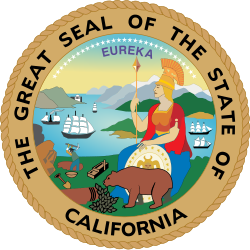California State Seal
| The Great Seal of the State of California | |
|---|---|

| |
| Details | |
| Armiger |
|
| Adopted | 1849 (followed by minor changes in 1883, 1891, and 1937) |
| Motto | Eureka |
| Other elements | Note that this artistic rendition does not include the mysterious building or show the smoke and engine identifying the two-masted vessel on the far left as a steamship. Both elements are described below. Also missing is the fifth ship, which should be seen sailing through the break in the mountains, directly at the viewer. |
The Great Seal of the State of California was adopted at the California state Constitutional Convention of 1849 and has undergone minor design changes since then, the last being the standardization of the seal in 1937. The seal shows the Roman goddess Minerva (Athena in Greek mythology), the goddess of wisdom and war, because she was born an adult, and California was never a territory; a California grizzly bear (the official state animal) feeding on grape vines, representing California's wine production; a sheaf of grain, representing agriculture; a miner, representing the California Gold Rush and the mining industry; and sailing ships, representing the state's economic power. The word Eureka (εύρηκα in Greek), meaning "I have found it", is the California state motto.
The original design of the seal was by U.S. Army Major Robert S. Garnett and engraved by Albert Kuner. However, because of the friction then in existence between the military and civil authorities, Garnett was unwilling to introduce the design to the constitutional convention, so convention clerk Caleb Lyon introduced it as his own design, with Garnett's approval. Garnett later became the first general to be killed in the Civil War, where he served as a Confederate general.
The legal definition of the Great Seal of the State of California is found in the California Government Code, Sections 399-405.
...
Wikipedia
